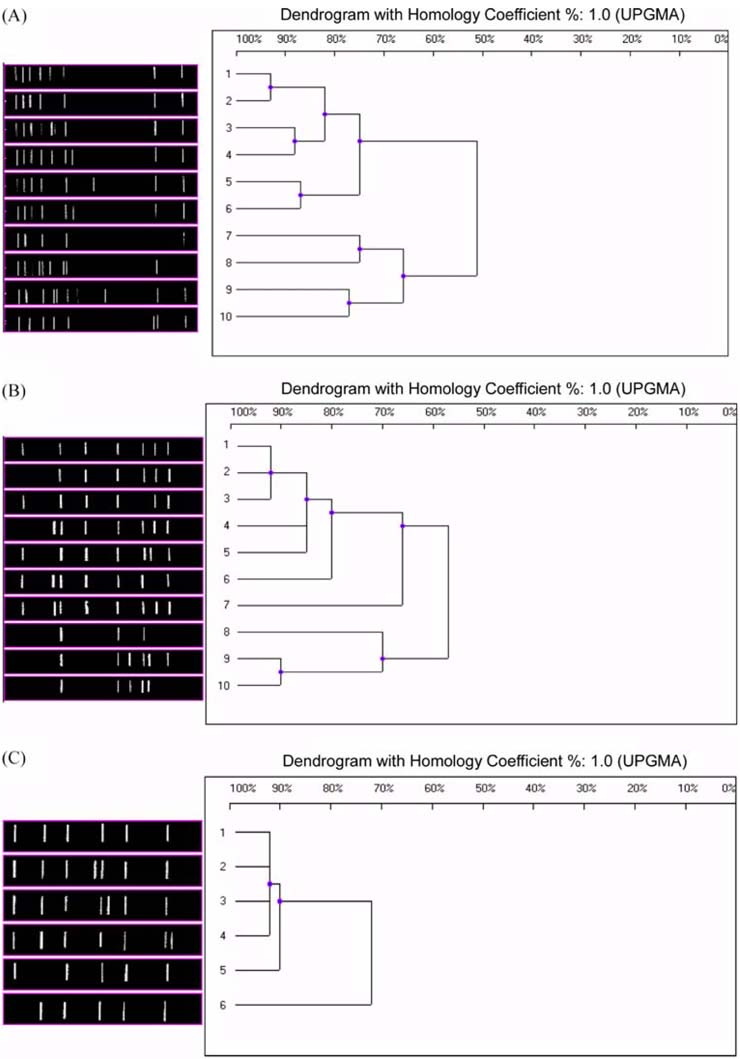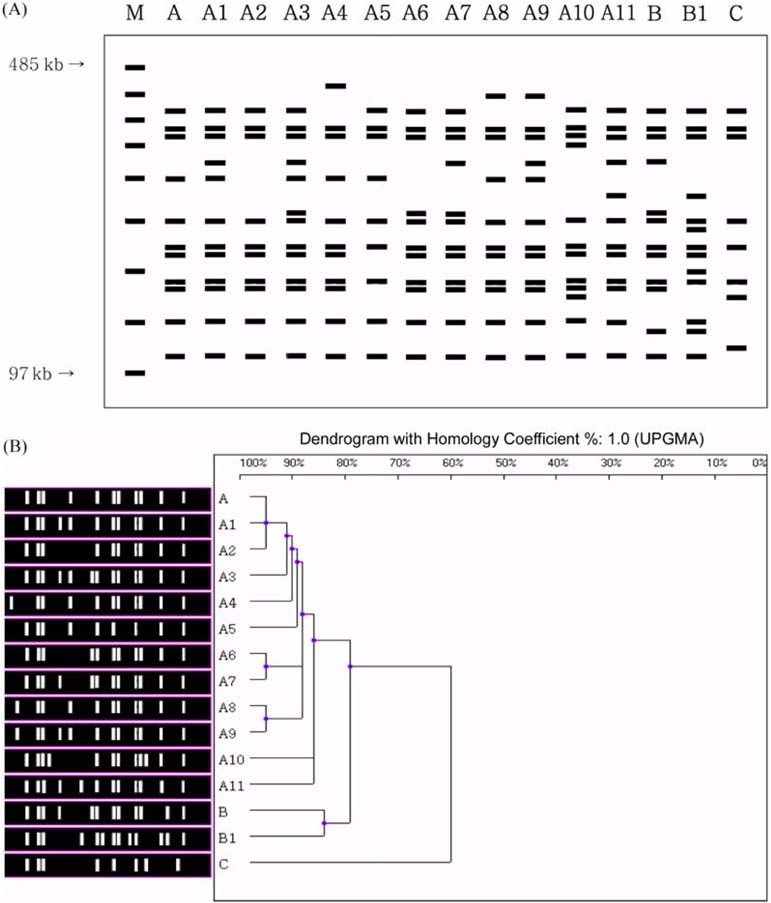J Vet Sci.
2007 Mar;8(1):65-73. 10.4142/jvs.2007.8.1.65.
Diversity of swine Bordetella bronchiseptica isolates evaluated by RAPD analysis and PFGE
- Affiliations
-
- 1South Branch, Gangwon Veterinary Service, Wonju 200-170, Korea.
- 2School of Veterinary Medicine, Kangwon National University, Chuncheon 200-701, Korea. twhahn@kangwon.ac.kr
- KMID: 1104238
- DOI: http://doi.org/10.4142/jvs.2007.8.1.65
Abstract
- The degree of genetic diversity in 45 Bordetella (B.) bronchiseptica strains comprised of a vaccine strain (N = 1), reference strains (N = 3) and field isolates (N = 41) was evaluated using random amplified polymorphic DNA (RAPD) fingerprinting and pulsed-field gel electrophoresis (PFGE). Three candidate primers were selected for RAPD analysis after screening 20 random decamer oligonucleotides for their discriminatory abilities. The OPA-07, OPA-08 and OPA-18 primers yielded 10, 10, and 6 distinct fingerprint patterns, respectively. The most common identical RAPD pattern was produced by OPA-07 which was shared by 32 isolates (71.1%), the pattern produced by OPA-08 was shared by 26 isolates (57.8%), and the pattern produced by OPA-18 was shared by 40 isolates (88.9%). The RAPD patterns of the vaccine strain and the 3 reference strains did not match any of the patterns produced by the field isolates when primers OPA-07 and OPA-08 were used. PFGE using the restriction endonuclease XbaI produced a total of 15 patterns consisting of 4 PFGE types (A, B, B1 and C, differing by > or = 4 bands) and 11 A subtypes (differing by < or = 3 bands). Most of the field isolates exhibited identical type A and B patterns, suggesting that they were related. The vaccine strain and the three reference strains showed different PFGE patterns as compared to the identical type A strains.
Keyword
MeSH Terms
Figure
Reference
-
1. Barbier N, Saulnier P, Chachaty E, Dumontier S, Andremont A. Random amplified polymorphic DNA typing versus pulsed-field gel electrophoresis for epidemiological typing of vancomycin-resistant enterococci. J Clin Microbiol. 1996. 34:1096–1099.
Article2. Baysinger A. PRDC: is it new or déjá vu? Pork '99. 1999. 19:64.3. Bemis DA, Burns EH. Gyles CL, Thoen CO, editors. Bordetella. Pathogenesis of Bacterial Infections in Animals. 1993. 2nd ed. Ames: Iowa State University Press;201–215.4. Bemis DA, Greisen HA, Appel MJ. Bacteriological variation among Bordetella bronchiseptica isolates from dogs and other species. J Clin Microbiol. 1977. 5:471–480.
Article5. Bemis DA, Plotkin BJ. Hemagglutination by Bordetella bronchiseptica. J Clin Microbiol. 1982. 15:1120–1127.6. Binns SH, Speakman AJ, Dawson S, Bennett M, Gaskell RM, Hart CA. The use of pulsed-field gel electrophoresis to examine the epidemiology of Bordetella bronchiseptica isolated from cats and other species. Epidemiol Infect. 1998. 120:201–208.
Article7. Chang N, Chui L. A standardized protocol for the rapid preparation of bacterial DNA for pulsed-field gel electrophoresis. Diagn Microbiol Infect Dis. 1998. 31:275–279.
Article8. Cowan ST, Steel KJ. Manual for the Identification of Medical Bacterial. 1974. 2nd ed. London: Cambridge University Press;89–90.9. Gautom RK. Rapid pulsed-field gel electrophoresis protocol for typing of Escherichia coli O157:H7 and other gramnegative organisms in 1 day. J Clin Microbiol. 1997. 35:2977–2980.
Article10. Giles CJ. Leman AD, Straw BE, Mengeling WL, D'Allaire S, Taylor DJ, editors. Bordetellosis. Disease of Swine. 1992. 7th ed. Ames: Iowa State University Press;436–445.11. Graham AC, Abruzzo GK. Occurrence and characterization of plasmids in field isolates of Bordetella bronchiseptica. Am J Vet Res. 1982. 43:1852–1855.12. Grimont F, Grimont PA. Ribosomal ribonucleic acid gene restriction patterns as potential taxonomic tools. Ann Inst Pasteur Microbiol. 1986. 137B:165–175.
Article13. Harris DL, Switzer WP. Turbinate atrophy in young pigs exposed to Bordetella bronchiseptica, Pasteurella multocida, and combined inoculum. Am J Vet Res. 1968. 29:777–785.14. Johnson R, Sneath PHA. Taxonomy of Bordetella and related organisms of the families Achromobacteraceae, Brucellaeae and Neisseriaceae. Int J Syst Bacteriol. 1973. 23:381–404.15. Keil DJ, Fenwick B. Evaluation of canine Bordetella bronchiseptica isolates using randomly amplified polymorphic DNA fingerprinting and ribotyping. Vet Microbiol. 1999. 66:41–51.
Article16. Khattak MN, Matthews RC. Genetic relatedness of Bordetella species as determined by macrorestriction digests resolved by pulsed-field gel electrophoresis. Int J Syst Bacteriol. 1993. 43:659–664.
Article17. Moissenet D, Valcin M, Marchand V, Grimprel E, Begue P, Garbarg-Chenon A, Vu-Thien H. Comparative DNA analysis of Bordetella pertussis clinical isolates by pulsed-field gel electrophoresis, randomly amplified polymorphism DNA, and ERIC polymerase chain reaction. FEMS Microbiol Lett. 1996. 143:127–132.
Article18. Musser JM, Hewlett EL, Peppler MS, Selander RK. Genetic diversity and relationships in populations of Bordetella spp. J Bacteriol. 1986. 166:230–237.
Article19. Pedersen KB. The serology of Bordetella bronchiseptica isolated from pigs compared with strains from other animal species. Acta Pathol Microbiol Scand Suppl. 1975. 83:590–594.20. Peppler MS, Schrumpf ME. Phenotypic variation and modulation in Bordetella bronchiseptica. Infect Immun. 1984. 44:681–687.
Article21. Register KB, Boisvert A, Ackermann MR. Use of ribotyping to distinguish Bordetella bronchiseptica isolates. Int J Syst Bacteriol. 1997. 47:678–683.22. Ross RF, Switzer WP, Duncan JR. Comparison of pathogenicity of various isolates of Bordetella bronchiseptica in young pigs. Can J Comp Med Vet Sci. 1967. 31:53–57.23. Rutter JM, Collings LA. Pedersen KB, Nielsen NC, editors. The virulence of Bordetella bronchiseptica in atrophic rhinitis of pigs. Atrophic Rhinitis in Pigs. 1983. Luxembourg: Commission of the European Communities;77–83.24. Sacco RE, Register KB, Nordholm GE. Restriction endonuclease analysis discriminates Bordetella bronchiseptica isolates. J Clin Microbiol. 2000. 38:4387–4393.
Article25. Seo YS, Lee SH, Shin EK, Kim SJ, Jung R, Hahn TW. Pulsed-field gel electrophoresis genotyping of Salmonella gallinarum and comparison with random amplified polymorphic DNA. Vet Microbiol. 2006. 115:349–357.
Article26. Smith IM, Baskerville AJ. A selective medium facilitating the isolation and recognition the Bordetella bronchiseptica in pigs. Res Vet Sci. 1979. 27:187–192.
Article27. Stull TL, LiPuma JJ, Edlind TD. A broad-spectrum probe for molecular epidemiology of bacteria: ribosomal RNA. J Infect Dis. 1988. 157:280–286.
Article28. Tenover FC, Arbeit RD, Goering RV, Mickelsen PA, Murray BE, Persing DH, Swaminathan B. Interpreting chromosomal DNA restriction patterns produced by pulsed-field gel electrophoresis: Criteria for bacterial strain typing. J Clin Microbiol. 1995. 33:2233–2239.
Article29. Tynkkynen S, Satokari R, Saarela M, Mattila-Sandholm T, Saxelin M. Comparison of ribotyping, randomly amplified polymorphic DNA analysis, and pulsed-field gel electrophoresis in typing of Lactobacillus rhamnosus and L. casei strains. Appl Environ Microbiol. 1999. 65:3908–3914.
Article30. Vu-Thien H, Dulot C, Moissenet D, Fauroux B, Garbarg-Chenon A. Comparison of randomly amplified polymorphic DNA analysis and pulsed-field gel electrophoresis for typing of Moraxella catarrhalis strains. J Clin Microbiol. 1999. 37:450–452.
Article31. Winstanley C, Shina A, Dawson S, Gaskell RM, Hart CA. Variation in Bordetella bronchiseptica flaA does not correlate with typing by macro-restriction analysis by pulsed-field gel electrophoresis. J Med Microbiol. 2001. 50:255–260.
Article32. Yuk MH, Heininger U, Martinez de Tejada G, Miller JF. Human but not ovine isolates of Bordetella parapertussis are highly clonal as determined by PCR-based RAPD fingerprinting. Infection. 1998. 26:270–273.
Article33. Zhang Y, Rajagopalan M, Brown BA, Wallace RJ Jr. Randomly amplified polymorphic DNA PCR for comparison of Mycobacterium abscessus strains from nosocomial outbreaks. J Clin Microbiol. 1997. 35:3132–3139.
Article
- Full Text Links
- Actions
-
Cited
- CITED
-
- Close
- Share
- Similar articles
-
- Bordetella bronchiseptica Respiratory Infection in the Immunosuppressed Patient
- Evaluation of the immunogenicity of Bordetella bronchiseptica, a vaccine antigen
- Pseudooutbreak of Acinetobacter spp. Bacteriuria Confirmed by 16S rRNA Gene Sequence Analysis
- Mac-1-mediated Uptake and Killing of Bordetella bronchiseptica by Porcine Alveolar Macrophages
- Genetic Diversity of Stenotrophomonas maltophilia Isolated from Clinical Specimens



